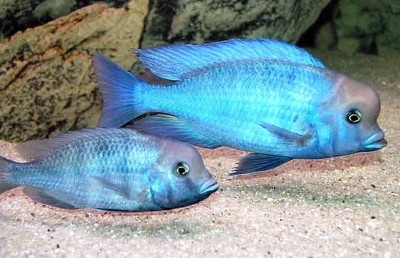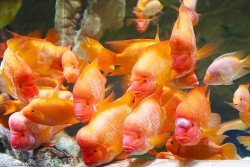Blue Dolphin Cichlid (Cyrtocara moori) CareSheet
 The Cyrtocara moorii, more commonly known as the Blue Dolphin Cichlid, is a captivating freshwater fish that has enchanted aquarists around the world with its vibrant blue hue and distinctive physical features. Native to the sandy shores of Lake Malawi in Africa, this species stands out not only for its striking appearance but also for its unique behavior and adaptability in home aquariums. The Blue Dolphin Cichlid is named for its dolphin-like head shape, which is particularly prominent in males, adding to its allure. With a peaceful temperament and a preference for spacious, well-maintained tanks, the Cyrtocara moorii is an excellent choice for both novice and experienced fish keepers. This guide will delve into the fascinating world of the Blue Dolphin Cichlid, covering everything from its natural habitat and dietary needs to breeding habits and tank requirements, ensuring you have all the information needed to care for this remarkable species.
The Cyrtocara moorii, more commonly known as the Blue Dolphin Cichlid, is a captivating freshwater fish that has enchanted aquarists around the world with its vibrant blue hue and distinctive physical features. Native to the sandy shores of Lake Malawi in Africa, this species stands out not only for its striking appearance but also for its unique behavior and adaptability in home aquariums. The Blue Dolphin Cichlid is named for its dolphin-like head shape, which is particularly prominent in males, adding to its allure. With a peaceful temperament and a preference for spacious, well-maintained tanks, the Cyrtocara moorii is an excellent choice for both novice and experienced fish keepers. This guide will delve into the fascinating world of the Blue Dolphin Cichlid, covering everything from its natural habitat and dietary needs to breeding habits and tank requirements, ensuring you have all the information needed to care for this remarkable species.Requirements for keeping Cyrtocara moori
The Cyrtocara moorii, commonly known as the Blue Dolphin Cichlid, is a striking freshwater fish native to the sandy shores of Lake Malawi in Africa. Known for its vibrant blue color and distinctive hump on its head, this species is a favorite among cichlid enthusiasts.
Appearance
- Color: Vibrant blue with small black markings.
- Size: Can grow up to 10 inches (25 cm) in length.
- Distinctive Features: Males develop a pronounced hump on their forehead.
Habitat
- Natural Habitat: Sandy coastal areas and rift lakes in Lake Malawi.
- Tank Requirements: Minimum tank size of 200-250 liters with a length of at least 5 feet. The tank should have sandy substrates and minimal stones to allow ample swimming space.
Water Conditions
- Temperature: 72-84°F (22-29°C).
- pH Level: 7.0-8.8.
- Water Hardness: Can tolerate saline conditions up to 10%.
Diet
- Type: Omnivorous with a preference for high-protein foods.
- Examples: Blood worms, shellfish, worms, high-quality pellets.
- Feeding Frequency: 3-5 small portions daily.
Lifespan and Breeding
- Lifespan: Up to 10 years.
- Breeding: Polygamous, with one male forming a nest with multiple females. Ideal ratio is one male to 3-5 females.

Amazing Cyrtocara moorii Aquarium and Beautiful Types of Cichlid Tanks
FAQ's
How do Blue Dolphin Cichlids interact with plants in the aquarium?
They generally do not harm plants but prefer open swimming spaces, so minimal planting is recommended.
Can Blue Dolphin Cichlids be kept in a planted tank?
Yes, but it's best to use hardy plants and ensure plenty of open space.
What are the signs of stress in Blue Dolphin Cichlids?
Signs include loss of color, erratic swimming, and hiding.
Do Blue Dolphin Cichlids need a lot of swimming space?
Yes, they are active swimmers and require ample space to thrive.
How do you differentiate between a juvenile and adult Blue Dolphin Cichlid?
Juveniles are smaller and lack the pronounced hump seen in adult males.
Can Blue Dolphin Cichlids live with invertebrates?
They may eat smaller invertebrates, so it's best to avoid keeping them together.
Do Blue Dolphin Cichlids make sounds?
No, they do not produce audible sounds.
How often should you change the water for Blue Dolphin Cichlids?
Regular water changes are essential, ideally 20-30% weekly.
Can Blue Dolphin Cichlids be kept with saltwater fish?
No, they are freshwater fish and require specific water conditions.
What type of lighting is best for Blue Dolphin Cichlids?
Moderate lighting that mimics their natural habitat is ideal.
Is it necessary to use air stones or oxygenators for Blue Dolphin Cichlids?
Yes, to ensure adequate oxygen levels in the tank.
How do Blue Dolphin Cichlids react to seasonal changes?
They are sensitive to temperature fluctuations, so maintaining stable conditions is crucial.
Can Blue Dolphin Cichlids be trained?
They can recognize their owners and may respond to feeding routines.
What type of substrate is best for Blue Dolphin Cichlids?
Sandy substrates are ideal to mimic their natural habitat.
Are Blue Dolphin Cichlids sensitive to medication?
Yes, always use medications specifically designed for cichlids.
How do Blue Dolphin Cichlids handle transportation?
They can be stressed by transportation, so handle with care.
Is it possible for Blue Dolphin Cichlids to jump out of the tank?
Yes, ensure the tank is covered to prevent jumping.
Can you keep multiple males in the same tank?
It's not recommended as males can be territorial, especially during breeding.
Do Blue Dolphin Cichlids change color?
Their color intensity can vary based on diet and water conditions.



